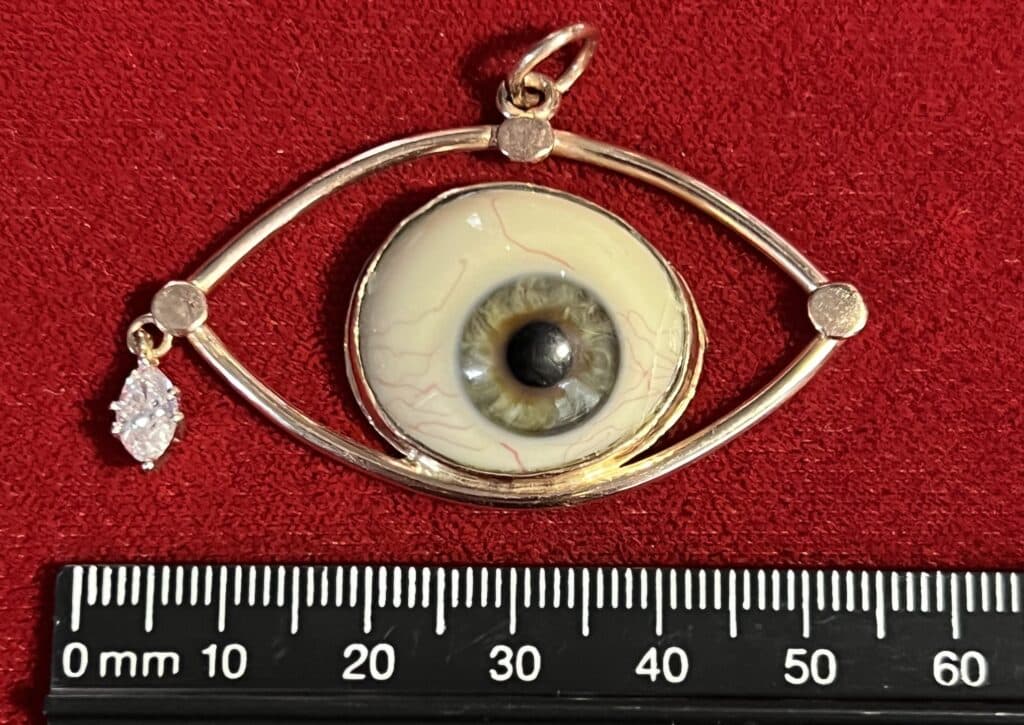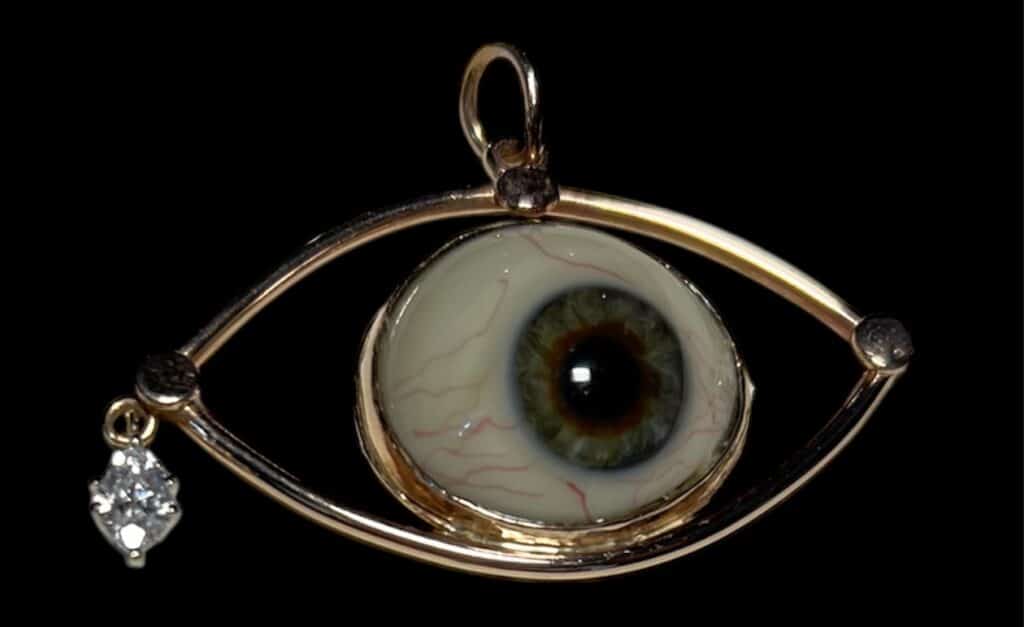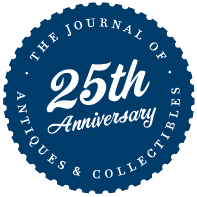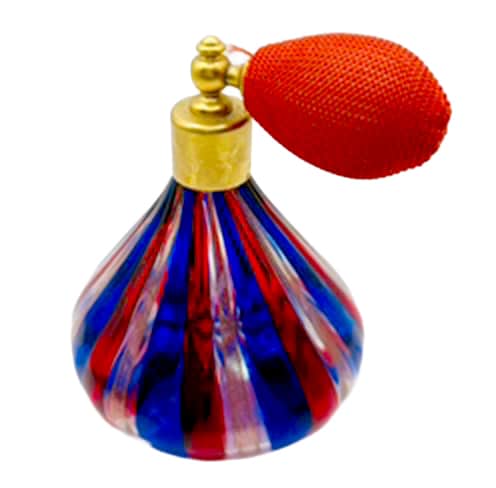Eye Witness to the Golden Eye
with Jessica Rickman CPPA, Certified Personal Property Appraiser

During a recent estate appraisal, imagine my initial shock when this stunning piece of jewelry from the collection literally stared right back at me…
According to family lore, the owner’s grandfather lost an eye while fighting in Europe during World War II. He wore this finely crafted prosthetic eye for the remainder of his life. This remarkable heirloom was passed down through the family until the present day. In the early 2000s, his grandson, with a spark of inspiration, decided to honor his grandfather’s legacy. He commissioned a piece of custom jewelry that blended the prosthetic eye into a design that reflected his own heartfelt creativity.
The stunning result is an eye-catching pendant both suitable for a movie set or straight out of a treasure chest. The eyeball is set in a solid gold eye-shaped frame, and adorned by a beautiful and authentic diamond “teardrop”. The quality of workmanship is exquisite, and the pendant is in excellent condition.
With Veteran’s Day occurring on November 11, I thought this piece would be appropriate for this month’s article. The owner was proud to provide permission for me to share photographs and history, as well as details from his formal appraisal.
Prosthesic Eyes in World War I & II
During World War I, the U.S. military faced a shortage of glass eyes. Protective eyewear was rare, leading to frequent eye injuries among both civilians and soldiers. American troops endured severe eye damage from combat, primarily due to artillery shrapnel, as well as from
diseases and the consumption of toxic wood alcohol. As a result, over eight hundred soldiers and sailors lost vision in one or both eyes, making military eye prosthetics essential. Ironically, at this time Germany, our enemy, had a near monopoly on the glass manufactured for use in optical prosthetics, and by the war’s end, the supply of glass eyes was almost depleted.
With the onset of World War II in 1939, glass for the production of prosthetic eyes was no longer available to Americans from Germany. As a result, the United States government commissioned American companies to develop techniques for manufacturing prosthetic eyes out of acrylic plastic. One of these companies was Bausch & Lomb, one of the largest manufacturers of contact lenses in America today.
Description and Analysis
A custom-crafted, high-polished 10-karat rose gold pendant featuring a figural eye motif, measuring 49 mm long, 27 mm wide, and 1.5 mm thick, the pendant includes a centrally mounted acrylic prosthetic human eye, set in a rose gold bezel, with a hazel-colored iris measuring 23 mm long by 19 mm wide. The frame has three 4 mm diameter tabs at the corners and top, and is suspended from a movable jump ring bail.
A marquise brilliant cut diamond, estimated at 0.65 carat, is set in a white gold six-prong closed-back setting, dangling from the left side. The diamond measures 7.7 mm long, 4.4 mm wide, and 3.1 mm deep, with SI2 clarity, E color, strong blue fluorescence, and a good cut grade.

The item is handcrafted and marked on the reverse with “Rose Gold By: D.A. 09,”. The pendant has been acid-tested as 10-karat gold, is in excellent condition, and weighs 10.2 grams.
Appraised Retail Replacement Value
I thoroughly examined and tested all relevant aspects of this piece in person. In determining a retail value, I calculated the intrinsic raw value of the gold content, the eye, and the diamond. I also considered the uniqueness of the design and the quality of the skilled handicrafting that went into producing it.
Although the eye is a unique custom piece, I located and took into account several recent comparable sales of custom jewelry pieces with similar gold content that incorporate a diamond of similar quality and size.
For insurance purposes, I can confidently assign a retail replacement value to this piece of $4,750.
Concluding Remarks
Given its shocking appearance and history, this piece is one of the most unique and exciting pieces of custom jewelry I have ever encountered. As this month corresponds with Veteran’s Day, I would like to conclude this month’s appraisal with one of my favorite poems —In Flanders Fields—by John McRae:
In Flanders fields the poppies grow between the crosses, row on row, That mark our place; and in the sky the larks, still bravely singing, fly scarce heard amid the guns below.
We are the Dead. Short days ago we lived, felt dawn, saw sunset glow, loved and were loved, and now we lie, in Flanders fields.
Take up our quarrel with the foe: to you from failing hands we throw the torch; be yours to hold it high. If ye break faith with us who die we shall not sleep, though poppies grow in Flanders fields.
Note: The value expressed herein is based on the appraiser’s best judgement and opinion for entertainment purposes only as of October 2, 2025, and is not a representation or warranty that the described item would realize that value should it be offered for sale at auction or otherwise, nor is it a guarantee of authenticity. For a full, formal, documented appraisal of your items for insurance or other purposes, please contact Jessica Rickman.
Jessica Rickman is an accomplished antiques and collectibles expert, bringing over a decade of experience as a dealer and certified personal property appraiser based in Nashville, Tennessee. With a degree from Belmont University and specialized training from the Asheford Institute of Antiques, Jessica combines academic rigor with a deep passion for preserving history through procuring unique historical items. For inquiries, connect with her via email at jessica@antiques615.com or Instagram, @antiques615.
Journal of Antiques & Collectibles and Asheford Institute of Antiques have teamed up to provide our readers with professional appraisers to help you learn more about and value your finds. We welcome your questions and photos. Send your information to info@joac.online To learn more about becoming a “certified” antiques appraiser, visit www.asheford.com.





